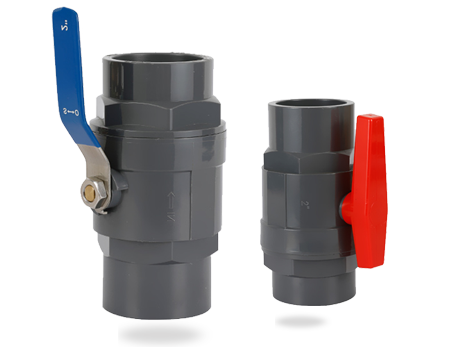How does the male ball valve design enable smooth and effortless on/off operation?
The male ball valve design is a key characteristic...
MORE >>















1. Design and Construction: The primary difference betw […]
1. Design and Construction:
The primary difference between UPVC two-piece and three-piece ball valves lies in their design and construction. Two-piece ball valves consist of two main components: a body with integrated end connections and a ball with a bore through it. In contrast, three-piece ball valves consist of three separate components: a body, a ball, and two end caps. The three-piece design allows for easier disassembly, maintenance, and repair of the valve.
2. Assembly and Disassembly:
Two-piece ball valves are designed for easier installation and replacement since they consist of fewer components. On the other hand, three-piece ball valves can be completely disassembled by removing the bolts and end caps, facilitating thorough cleaning, inspection, and component replacement if needed. The ability to disassemble and reassemble three-piece ball valves offers added flexibility and convenience during maintenance and repairs.
3. Applications and Flow Control:
Both two-piece and three-piece UPVC ball valves are suitable for a wide range of industrial applications. They are commonly used for handling various fluids such as water, acids, alkalis, chemicals, and slurries. These ball valves provide reliable flow control, allowing for full flow or complete shut-off. Their robust construction and corrosion resistance make them suitable for industries such as water treatment, chemical processing, food and beverage, pharmaceuticals, and agriculture.
4. Pressure and Temperature Ratings:
The pressure and temperature ratings of two-piece and three-piece UPVC ball valves may vary. Generally, two-piece ball valves have slightly lower pressure and temperature ratings compared to their three-piece counterparts. It is essential to consider the specific requirements of the industrial application, including the pressure and temperature conditions, to ensure the chosen ball valve can handle the intended operating environment effectively.
5. Size and Port Options:
Both two-piece and three-piece UPVC ball valves are available in various sizes to accommodate different pipeline requirements. They typically range from smaller sizes, such as 1/2" or 3/4", up to larger sizes, such as 6" or even higher. Additionally, these ball valves offer different port options, including full port and reduced port. Full port valves have a larger ball opening, allowing for maximum flow capacity, while reduced port valves have a smaller ball opening, suitable for applications where lower flow rates are acceptable.
6. Chemical Compatibility:
UPVC ball valves are known for their excellent chemical resistance. They are compatible with a wide range of corrosive and non-corrosive fluids. However, it is important to consider the specific chemical properties and compatibility of the fluids being handled. Certain aggressive chemicals or high-temperature applications may require additional valve modifications or alternative materials to ensure optimal performance and longevity.
7. Cost Considerations:
The cost of UPVC two-piece and three-piece ball valves may vary. Generally, two-piece ball valves are more cost-effective due to their simpler design and fewer components. Three-piece ball valves, with their ability to be fully disassembled, may be slightly more expensive upfront but can offer long-term cost savings through easier maintenance, repair, and component replacement.


The male ball valve design is a key characteristic...
MORE >>
In today's modern world, efficient and reliable wa...
MORE >>
Copyright ©All rights reserved:Zhejiang Xier Plastic Valve Lead Co.,LTD. PVC Ball Valves Manufacturers Technical support: HWAQ  浙公网安备 33060402001174号
浙公网安备 33060402001174号

 English
English España
España عربي
عربي